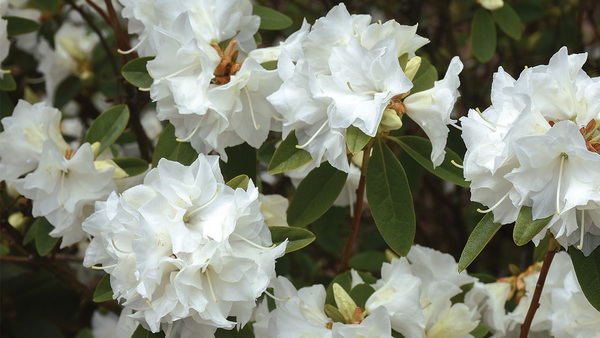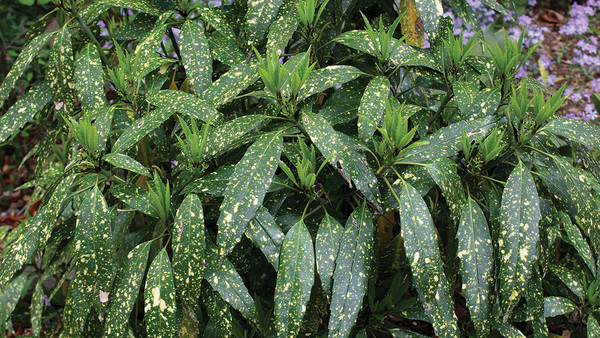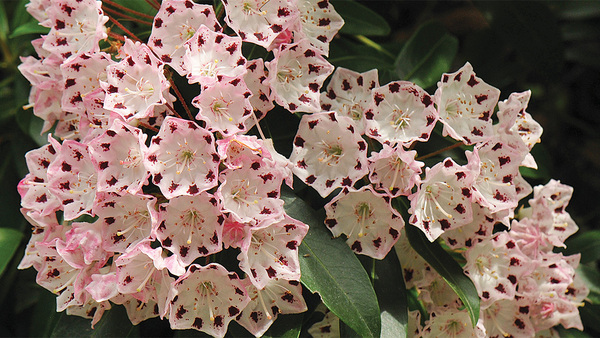
There are few groups of plants more valuable in the garden than broadleaf evergreens. They give the garden structure and interest when not much else is going on. This varied group generally includes any woody plant that does not lose its leaves during the fall or winter and is not a conifer with needles or scales (think pines, junipers, firs, or arborvitae). Broadleaf evergreens represent some of our most popular and useful shrubs: rhododendrons, camellias, hollies, and boxwood. These plants offer a wide range of textures through their varied foliage and can often be complemented with beautiful flowers and a lovely growing habit.
Unfortunately, having so much leafy surface area exposed to the vagaries of winter weather means that broadleaf evergreens can be damaged by cold more easily than other plants, so they are used more frequently in milder areas (Zones 7–11) than in colder areas. Although in colder zones the choices are more limited, there are still some very useful plants that will tolerate Zones 5 and 6, and with protection a few will even survive in Zone 4, where the average winter temperature can drop to a chilling –20° to –30°F. The following are a few of my favorite broadleaf evergreens, ones that do more than just simply add green to the garden in the off-season.
Spectacular flowers are delicious icing to an already tasty cake
A long-blooming stunner from a genus filled with beauties

Name: ‘Donation’ camellia (Camellia × williamsii ‘Donation’)
Zones: 7–9
So many broadleaf evergreens have breathtaking displays of bloom that entire libraries can be dedicated to them. One of the classics is camellia. There are many species and hundreds of cultivars of this staple of the Southern garden to choose from. With thoughtful selection in mild climates, blooms can flourish from early autumn to midspring. In areas prone to occasional cold blasts and long winter rains, I prefer Camellia × williamsii. This hybrid between a winter- and spring-blooming species provides long-lasting flowers at a time of the year when few other plants are blooming.
One of my favorite cultivars is ‘Donation’ camellia, which does well in full sun to partial shade. This large shrub covers itself in bloom and practically glows on a gray winter day. Its large, semi-double, bright pink flowers start opening in late winter and carry on into midspring. One of its best features is its tendency to drop its flowers once they begin to fade instead of hanging onto ugly brown blooms, as the more common C. japonica is prone to do. ‘Donation’ can reach 6 to 7 feet tall and 5 to 6 feet wide in 10 years, with an ultimate height of 10 to 12 feet. Giving it space to grow will allow you to enjoy its full beauty.
A little-known, intensely fragrant evergreen

Name: Burkwood’s sweet olive (Osmanthus × burkwoodii)
Zones: 7–9
Another late winter to early spring bloomer is Burkwood’s sweet olive. As spring bulbs are just awakening, this shrub covers itself with small, tubular white flowers that are intensely sweet in fragrance and can perfume the entire garden. This adaptable shrub tolerates full sun to dappled shade and drought conditions. It can also be clipped and sheared into tight hedges or allowed to grow freely and become a striking large shrub or a small multistemmed patio tree. A moderate grower, it will reach 6 to 7 feet tall in 10 years and can become 12 to 15 feet tall and wide as an older plant.
A small shrub with big impact

Name: ‘Elf’ mountain laurel (Kalmia latifolia ‘Elf’)
Zones: 5–9
In particular, I appreciate compact selections such as ‘Elf’ mountain laurel. This slow-growing evergreen reaches about 3 feet tall and wide in 10 years and produces dense clusters of delicate, pink, balloon-like buds that open to gleaming white cup-shape blooms at the beginning of summer. Mountain laurel enjoys the same growing conditions as rhododendrons (moist, well-drained,
acidic soil), but it will tolerate more sun, which provides a better bloom.
Unique habits add an extra level of interest
One of the most underrated qualities of broadleaf evergreens is the interesting growth habits and branching patterns some of them have. Too often they are sheared into round balls or irregular squares and not allowed to show their true form. Evergreen foliage can be used to hide poor branching, but it can also emphasize strong and eye-catching structural branching.

Think of this guy as a small-scale focal point
Name: Columnar Japanese holly (Ilex crenata* ‘Mariesii’)
Zones: 5–8
One shrub with a particularly interesting habit is columnar Japanese holly. Japanese hollies have clean, tidy, and shiny dark green leaves, as well as none of the sharp spines associated with most other hollies. In addition, they have great drought tolerance. The columnar form ‘Mariesii’ has rigid upright growth with short side branches that create a slightly irregular architectural tower. It grows slowly and only reaches a height of 4 to 5 feet, with a width of only 1 foot, in 10 years.
Bet you’ve never seen a privet like this before

Name: Round-leaf Japanese privet (Ligustrum japonicum* ‘Rotundifolium’)
Zones: 8–9
Another tough shrub with especially unique and interesting branching is round-leaf Japanese privet. It has an upright and compact habit, as well as dense, bright, polished green leaves. As this shrub grows, it has a billowy branching habit that reminds me of a rising thunderhead cloud. It grows more slowly than most other privets, reaching 5 feet in 10 years and with a spread of 2 to 2-1/2 feet. Both of these reliable plants grow well in full sun to dappled shade.
Low growers are as practical as they are beautiful
A tiny treasure that fits almost anywhere

Name: ‘Morris Midget’ Japanese boxwood (Buxus microphylla var. japonica ‘Morris Midget’)
Zones: 4–9
In the urban landscape and in smaller gardens, plants with a reduced footprint are sought after highly. There are quite a few broadleaf evergreens that fit this mold, dwarf boxwood being a popular one. One of the most compact is ‘Morris Midget’ Japanese boxwood (photo above). In the world of boxwood, it fits comfortably in the adorable category. It has a tight, dense mound, with bright green foliage reaching about 1 foot tall and 2 feet wide in 10 years; it rarely grows taller than 2 feet with a 4-foot width. The only drawback is that in areas where boxwood blight can be a problem, this cultivar has shown some susceptibility. If you are in a boxwood-blight region, the similar but slightly wider and more open ‘Nana’ dwarf Korean boxwood (Buxus sinica var. insularis ‘Nana’, Zones 6–9), is a good substitute. Both choices take full sun to partial shade.
It’s a great juniper alternative

Name: Canby’s mountain lover (Paxistima canbyi)
Zones: 4–8
One of the most cold-tolerant broadleaf evergreens is the North American native Canby’s mountain lover. This low, spreading shrub is sometimes commonly called “cliff green” or, more disturbingly, “rat stripper,” due to native wood rats stripping the leaves and bark off in winter in a desperate search for food. Growing to 2 feet tall with a spread of 4 to 5 feet, Canby’s mountain lover has the look of an informal, loosely branched boxwood and is ideal for woodland gardens and more relaxed gardening styles. It is at its best in light to deep shade and can be quite useful for the darker areas in the garden.
Ground covers don’t get any prettier than this

Name: Irish heath (Daboecia cantabrica)
Zones: 6–9
Two other low-growers that not only have evergreen leaves but put on a nice floral show are Irish heath and alpine mint bush. The Irish heath grows as a low, wide mound and produces some of the largest flowers of the hardy heaths and heathers. Masses of cerise red, pink, white, or lavender urn-shape blooms dance above the foliage on short stems. Flowering begins in early summer and can last four to six weeks. Once the heath is finished flowering, a light shearing keeps it tidy and compact for the rest of the year.
Deer don’t like it, but you sure will

Name: Alpine mint bush (Prostanthera cuneata)
Zones: 7-10
The alpine mint bush is equally delightful, with tiny evergreen leaves that give off a pungent minty fragrance when lightly brushed, making the plant resistant to deer. It grows about 2 to 3 feet tall and 4 to 6 feet wide. The tiny foliage gives way to small but brilliant white flowers in early summer to midsummer. This Australian native requires a mild climate to grow successfully, and it appreciates well-drained soil. It and Irish heath are choice shrubs, flowering their best in full sun.
These shrubs are just a sliver of what is available and provide a small glimpse of the diversity of foliage, flowers, and growing habits that make broadleaf evergreens so desirable.
Protecting broadleaf evergreens in winter
In colder climates, broadleaf evergreens can be susceptible to drying out during winter, with the leaf edges being burnt in what is commonly referred to as winterburn (desiccation). This is caused when the sun or wind removes water from the leaves faster than it can be replaced by water from the stems and roots. As temperatures drop and the soil freezes, the free movement of water into the roots and up the stems is hampered. Shrubs in shade and in places with limited air movement are less likely to show this damage, but under prolonged below-freezing conditions, winterburn can still occur. The optimal method to protect plants, which is used commonly, involves constructing a barrier to limit airflow and to shade the shrub. Barriers are usually made with wooden stakes and burlap and are most effective for small to medium-size shrubs.

Place three stakes in a V-pattern around the plant you are protecting so that the point of the “V” is facing the direction of the most sun or prevailing winds. Once the stakes are driven into the ground, they should be about 1 foot taller than the shrub being protected. This can be done any time in the fall when weather and time permit. In late fall to early winter once the shrub in is full dormancy, burlap can be wrapped and stapled to the stakes. Attach the burlap on the two sides facing the most wind and sun, leaving the third side open to allow some light and airflow to reach the foliage. Depending on the tightness of the burlap weave, one to two layers should be enough.
*Invasive alert: Japanese holly (Ilex crenata)
This plant is considered invasive in NJ and TN.
*Invasive alert: Japanese privet (Ligustrum japonicum)
This plant is considered invasive in AL, GA, NC, PA, SC, and TN.
Please visit invasiveplantatlas.org for more information.
Richie Steffen is the director/curator for the Elisabeth C. Miller Botanical Garden in Seattle.
Sources:
- Broken Arrow Nursery Hamden, CT; 203-288-1026; brokenarrownursery.com
- Forestfarm Williams, OR; 541-846-7269; forestfarm.com
- Nature Hills Nursery Omaha, NE; 402-934-8116; naturehills.com
- Rare Find Nursery Jackson, NJ; 732-833-0613; rarefindnursery.com


















Comments
Log in or create an account to post a comment.
Sign up Log in